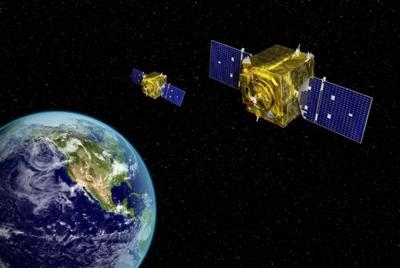Received Request To Help Locate Satellite That Did Not Achieve Planned Orbit
Air Force Space Command’s “Neighborhood Watch” satellites, from the Geosynchronous Space Situational Awareness Program, recently responded to the Navy’s request for help with a satellite of its own.

The Joint Functional Component Command for Space officially tasked the 1st Space Operations Squadron to support the Navy’s ongoing Mobile User Objective System-5 anomaly effort after the satellite failed to reach its target geosynchronous orbit July 3.
Anomaly resolution in space is challenging for many reasons, one being it’s difficult to see what’s going on with the satellite. Traditionally, engineers, analysts and operators comb through telemetry to come up with possible reasons for the anomaly; however, in cases like this, GSSAP is able to provide electro optical space situational awareness on the status of space objects to include location, orbit and size of the space object.
GSSAP crews conduct rendezvous and proximity operations to get the best possible vantage point for collecting SSA data when requested. In this case, the mission was to help rescue MUOS-5.
Once tasked, the 1st SOPS mission planning cell began deliberate, customized mission planning to determine how to execute the operation and maximize the probability for success. The satellites’ differing orbits and the various forces at play, including astrodynamics, reminded crewmembers that success was not inevitable.
Capt. Barbara Dyer, the 1st SOPS mission commander, led the crew that accomplished the command and control operations to collect MUOS-5 imagery on her 10th shift.
“I knew we were prepared. We had completed the rehearsal of concept for the unique mission,” she said. “We recognized the newness of what we’re doing will drive new expectations.”
Second Lt. Nathan Paddock is the satellite vehicle operator who executed the command and control for the operations.
“There were a lot of different people on the operations floor during the shift,” he said. “Senior leadership was there encouraging us and reminding us that this was something very important. I am new to the Air Force and the job, but knowing leadership trusted me and expected excellence is something that’s unique to this work.”
The audience and mission importance added to the pressure to achieve success, but that didn’t deter Paddock.
“I liked it. I thrive under pressure,” he said. “The crew engineers gave us a lot of support and helped me stay calm and relaxed. I know they had my back.”
The crew conducted SSA missions with other 1st SOPS assets, like the Space Based Space Surveillance system, in preparing for and during the mission.
While planning and operations were conducted at Schriever Air Force Base, another aspect of this unique mission occurred at Point Mugu, California.
“Due to the complexity of the program, we wanted someone on site to provide context to Navy leadership, explain our operations, facilitate information sharing and ensure there was robust coordination during the operations,” said Lt. Col. Casey Beard, the 1st SOPS commander.
The squadron’s mission planning cell chief, Capt. Brett Kasischke, was just up the road at Vandenberg AFB, California, to participate in an exercise. He capitalized on the opportunity and extended his stay in California.
“I quickly immersed myself into the mission’s requirements and served as an intermediary; I ensured data was sent at appropriate times as well as supported the team back at Schriever,” Kasischke said.
The mission’s full impact is yet to be determined, but there are successes already to be celebrated.
“I am proud of the team effort across the community,” Beard said. “From our crew here at Schriever to the Space and Missile System Center, the Joint Functional Component Command for Space, the Joint Space Operations Center, our Navy counterparts at Point Mugu and the contractors who dedicated 800 hours to mission planning, it was a true team effort and couldn’t have happened without everyone coming together.”
(Image provided with USAF news release)
 ANN's Daily Aero-Term (04.20.24): Light Gun
ANN's Daily Aero-Term (04.20.24): Light Gun Aero-News: Quote of the Day (04.20.24)
Aero-News: Quote of the Day (04.20.24) ANN's Daily Aero-Linx (04.21.24)
ANN's Daily Aero-Linx (04.21.24) Aero-News: Quote of the Day (04.21.24)
Aero-News: Quote of the Day (04.21.24) ANN's Daily Aero-Term (04.21.24): Aircraft Conflict
ANN's Daily Aero-Term (04.21.24): Aircraft Conflict



